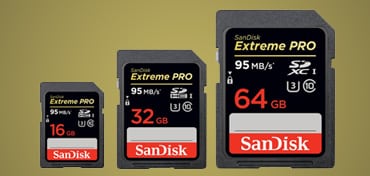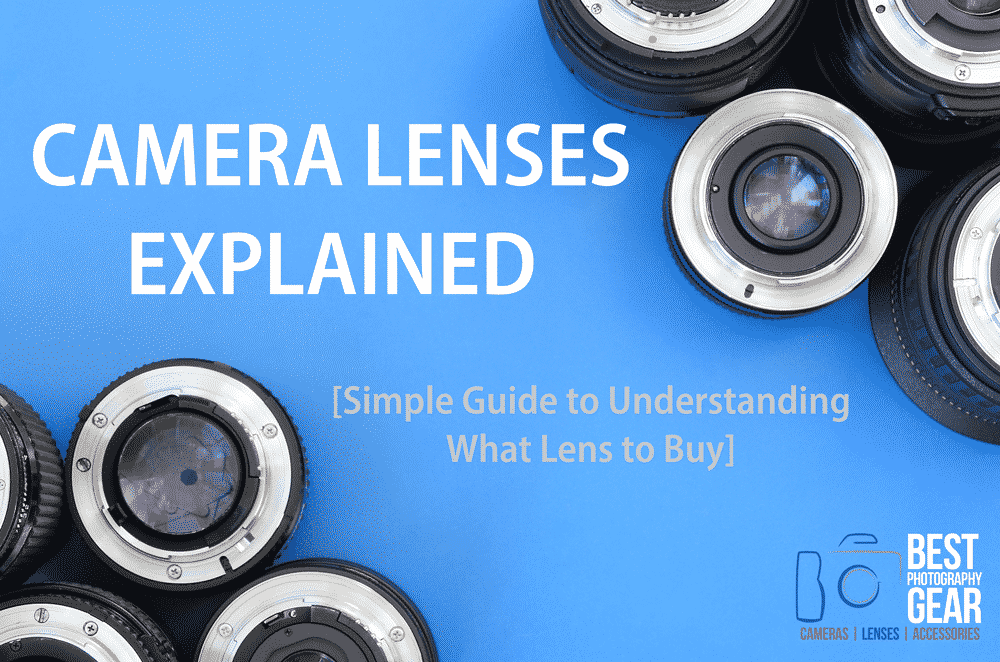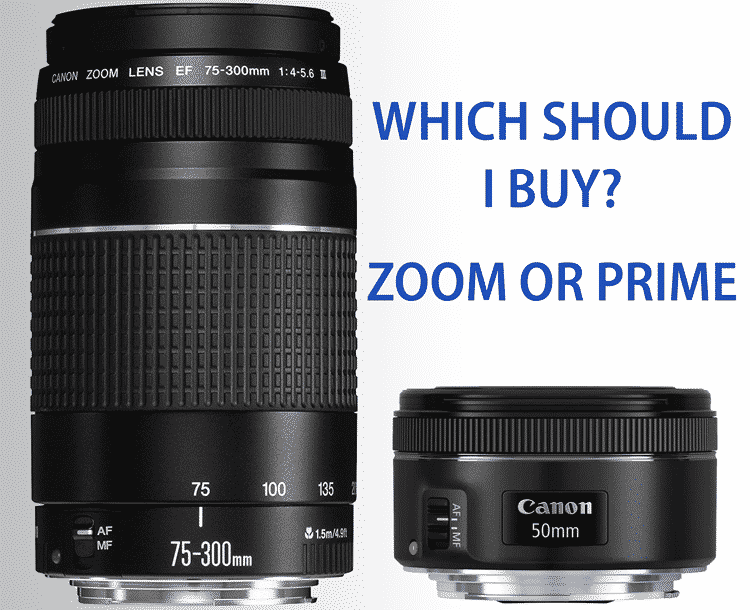The two key features you should consider when choosing a memory card for your camera are the Speed and Capacity of the card.
Since so many Digital Cameras can now shoot 10 frames per second with at least 20 megapixels, and especially with the introduction of 4K and 8K video at 60fps, you need an SD card that can write these large files quickly.
There are a ton of different memory card brands out there. Plus different terms and expressions. So it can be quite overwhelming when trying to figure out if a certain card is fast enough as well as compatible with your camera.
For now we are just going to be focusing on SD cards, which are the most popular type because they are interchangeable with many types of devices and cameras.
When you finish reading through this article be sure to check out our individual review for your camera model to see the best memory card options.
Table of Contents
ToggleWhat to Remember about Memory Cards
Here are a couple key things to remember when choosing a memory card for your DSLR or Mirrorless Camera.
ALWAYS buy more than one SD card
Your camera is important but the pictures saved on your card are usually more important.
This is true of professionals as well as for the hobbyist.
- First off, memory cards don’t last forever.
- Secondly, it’s a real pain when you’re in the middle of shooting to have to delete photos if you’re out of space. It’s much easier to just pop in another card.
- Third, take advantage of the two memory card slots in your camera. Not every camera has this feature, but if it does you might as well use it.
Back on running out of room. We suggest you have two to four cards for your camera. That way you can setup a nice rotation of your memory cards.
One card in the camera, a second with you as a backup, then a third or fourth at home where you’re loading the photos to your computer. Then simply rotate the cards once done with your photoshoot.
Even if you’re not a professional photographer having a rotation for your cards is a best practice.
I had a old base line iPad with only 16GB and I can’t tell you how many times I’ve had to try and find stuff to delete because I was out of space.
As we mentioned above, many cameras now offer two card slots. You can use these two slots in a lot of different ways. For example, one for stills and the other for videos.
Another option is to use the second slot as a backup, so you have two sets of the pictures incase something goes wrong. Just make sure that you get the right kind of card for the slot. Some cameras have two slots but they are for two different types of cards.
Card size isn’t as important as buying more than one card
Cards are relatively inexpensive these days, and it’s always nice to have a card with a larger capacity. However, don’t spend your money on buying a single memory card with a huge amount of storage capacity. That’s just asking for something to go wrong. Instead buy two or more cards.
If the choice was between a 128GB memory card and two 64GB cards (or even three 32GB cards), you should always get the two 64GB or three 32GB cards. As mentioned above, cards don’t last forever, and it’s much nicer to have multiple cards to rotate through your camera and loading to your computer then trying to deal with a single card. If you have the need for the 128GB size or more go for it, just make sure you get a couple of them.
Don’t buy a memory card just because it’s a few dollars less
Sometimes it feels like expenses build up with photography equipment but a memory card is not a place to try and save a little money.
Regardless of what you spent on your camera or your glass, if you buy a bad memory card it’s just going to slow down your ability to use your camera to its fullest. Or worse, you might loose your photos if a cheap card ends up dying on you.
You’re peace of mind alone is worth the cost.
If you see a card for more than a few dollars less then the major brands there’s a good chance it’s an inferior brand, or the specs are going to limit your camera’s capabilities in some way.
What Matters Before Buying an SD Card?
Speed
A memory card needs to be fast enough so you don’t have to wait a long time before you can start taking pictures again.
It may not sound like a lot on paper, but in real life events (think weddings, where every moment matters), that one second could actually be one of your best shots.
If you’ve got a fast camera (meaning over 5 frames per second shooting speed) with a large buffer size, you also need to be careful not to choose something that is going to slow you down.
This especially applies to video. So if you have Full HD at 60fps or 4K, you’ll need to get memory cards that are quite fast.
| Class | Speed | Our opinion |
| Class 4 | 4MB/s | Too slow for most modern cameras. Skip it. |
| Class 6 | 6MB/s | A little bit better but unless you take 3 pictures a year, skip it. |
| Class 10 | 10MB/s | Good enough for most cameras with 20+ megapixels and Full HD video. |
| U1 (UHS) | 10MB/s | Good enough for most cameras with 20+ megapixels and Full HD video |
| U3 (UHS) | 30MB/s | Perfect for fast burst cameras, Full HD at 60fps and 4K video |
The U1 and U3 classes belong to UHS-I and UHS-II type cards, which are faster than non-UHS (basically all cards with ‘Class 10’ and lower). It stands for Ultra High Speed.
You’ll notice this on the label of the memory card. At first I though it looked like a number sitting in a cup, but I realized the cup is actually a “U”. So if you see a “3” inside that U then you should be good for fast bursts and 4K video.
If you have a new or really high-end camera or do a lot of videography then make sure to check if you have the option of using a UHS-II type card. A UHS-1 card would still work, and are much less expensive, but they may not give you as quick of speeds.
Always remember to focus on the minimum Writing Speed (aka: picture taking speed) of the card and not Reading Speed (which is what most companies push the most and advertise on their cards because it looks better). Yes, it helps knowing how quickly you can transfer those shots to your computer, but that’s about it.
It’s a pain when it ‘takes forever‘ for your images to download to your computer, but it’s much more painful waiting for your camera to buffer or refresh when you’re trying to get the shot you want.
Compatibility
With SD cards you’ll see some common expressions or terms. SD, which means Secure Digital, were kind of the first generation memory cards. This is also a generic term now, for memory cards. Kind of like the company name “Kleenex” being referred to for ’tissues’.
Now a days you’ll also see SDHC and SDXC memory cards. In simple terms these are just newer generations of cards that allow for more storage and faster writing (aka: picture taking) and reading/transfer (aka: download) speeds.
It’s important to check that your camera can use either SDHC or SDXC memory cards.
Many newer cameras can use both. SDXC is the newer of the two, thus generally it will have faster writing (again that means picture taking) and transfer (again think downloading to your computer) speeds. These letters can be noticed on the card’s label if you look for them.
Cameras and devices that use SDXC generally accept SDHC cards as well. However, if a camera was only designed for SDHC then the newer SDXC card won’t work in it. Though even a camera like the Nikon D610 from 2013 can use SDXC cards. So speed class, as discussed above, is more often something to confirm so that you’re maximizing your camera’s features.
The physical size of the card is another thing to check for. As can be seen in the image below (from left to right) there are micro, mini, and standard size cards. So confirm what size your camera can use.
Capacity

Depending on your megapixels and video resolution, the capacity is also very important.
With memory cards being so cheap, we recommend you to get a minimum of a 16GB card or bigger.
It’s also much better to buy a few smaller cards as you minimize the risk of losing all of your shots. For example, having 2 x 64GB cards compared to just 1 x 128GB would mean losing everything if you only had that 128GB card. This obviously depends on your needs and what you shoot, but it never hurts to be careful.
How many shots can you store on 16GB, 32GB, 64GB and 128GB cards? SanDisk has a great table for JPEG and RAW files here.
Durability
For a professional this might be a little more critical but it’s something to consider even for a beginner photographer. Many SD memory cards are labeled as “extreme” or “professional” which generally will refer to their durability. Often you’ll see cards that are designed to be waterproof, shockproof and X-ray proof. In addition it’s important to consider the temperature range a card can work at.
Brands
We recommend buying a memory card from any the following brands; Sandisk, Lexar, Transcend, Sony, PNY and Kingston. Personally, I own a couple of Lexar and Sandisk cards, and have been perfectly satisfied with both for many years.
Any weird company or something ultra cheap will only result in you losing your shots sooner or later. You might be tempted to save a few bucks here, but think about it… this is the only place where all of your shots are stored. Yes you can always backup later, but you don’t always have to chance to do that immediately right?
Related Guides
First and foremost, I’m a husband and father. Then professionally I’m photographer, designer, blogger, and Esty store owner. My homebase is near the stunning Wasatch mountains in Utah but I love traveling with my family as part of our homeschooling journey. I also love teaching and helping out others. My faith is one of the biggest aspects of my life and brings be a consistent joy that I haven’t found in anything else. My main blog is BestPhotographyGear.com and I strive to make photography simple for anyone looking to learn or find gear for their individual needs. By nature, I like to study, research, and analyze things and I use that help provide the best advice and reviews I can.



